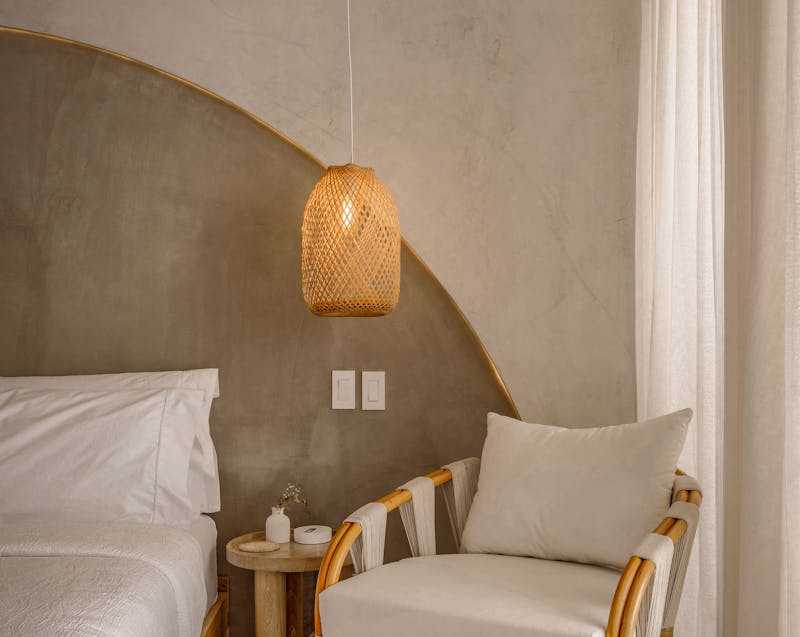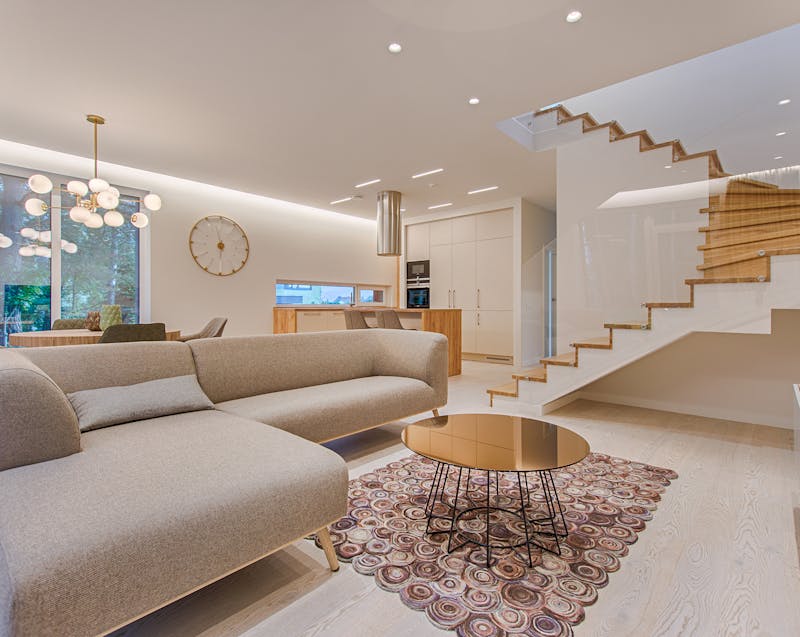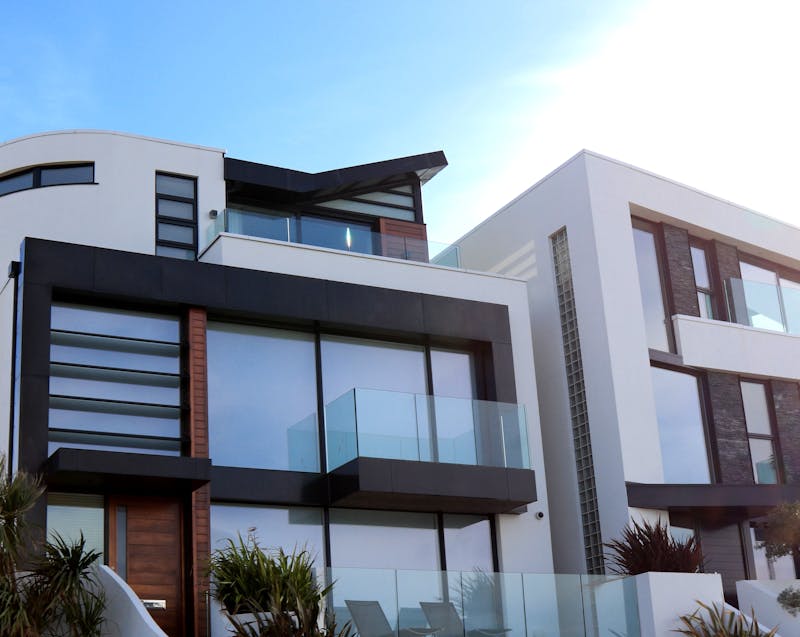
- Smart home technology has become standard in modern construction, offering convenience, energy efficiency, and future-ready infrastructure.
- Sustainable and eco-friendly materials such as recycled steel, bamboo, and solar-ready systems are shaping greener, healthier homes.
- Flexible and open-concept floor plans allow homeowners to adapt spaces for remote work, family growth, and lifestyle changes.
- Energy-efficient and passive design principles help reduce utility costs while maintaining year-round comfort.
- Biophilic and minimalist design styles promote relaxation, organization, and a stronger connection with nature.
- Multi-generational layouts and aging-in-place features ensure accessibility, safety, and long-term usability.
- Outdoor living spaces and digital personalization tools like 3D and VR design are redefining how homeowners experience and customize their homes.
The homebuilding landscape is evolving faster than ever, reflecting the changing needs and priorities of modern homeowners. From smart technology integration to sustainable materials, today’s home designs emphasize efficiency, comfort, and longevity. As lifestyles become more dynamic and environmentally conscious, home builders are redefining what makes a house both beautiful and functional.
This in-depth guide explores the top home design trends that are shaping new homes in 2025. Whether you’re planning to build your dream home or update your current space, these insights can help you understand what forward-thinking builders are focusing on—and how you can benefit from these innovative designs.
Smart Home Integration: The Rise of Connected Living
In 2025, smart home technology is no longer considered a luxury—it’s becoming a standard feature in new residential construction. Home builders are incorporating built-in smart systems that enhance convenience, safety, and energy efficiency.
Smart homes use interconnected systems that can be controlled via smartphones, tablets, or voice commands. These systems allow homeowners to automate tasks such as lighting, temperature regulation, and security, creating a seamless and comfortable living experience.
Key smart home trends include:
- Integrated energy management: Systems that track and optimize power usage, helping reduce monthly energy bills.
- Smart lighting solutions: Motion sensors and ambient light detectors that automatically adjust brightness based on activity and time of day.
- Enhanced home security: Builders are incorporating pre-wired smart locks, cameras, and video doorbells to ensure safety and convenience.
- Voice-controlled appliances: Integration with AI assistants allows homeowners to control devices hands-free.
- Future-proof wiring: Builders are preparing homes for future technologies by installing robust data networks and centralized control panels.
The goal is to create homes that not only make life easier but also add long-term value. For instance, homes with smart systems typically have higher resale appeal, as buyers increasingly expect such features.
Sustainable and Eco-Friendly Building Materials

Sustainability continues to drive major innovations in residential construction. Home builders are prioritizing eco-friendly materials that reduce environmental impact without compromising durability or aesthetics.
Today’s environmentally responsible homes are designed to conserve resources and minimize waste. Builders are choosing materials that are recyclable, renewable, or sustainably sourced. This approach not only benefits the planet but also results in lower utility costs and healthier indoor air quality for homeowners.
Examples of sustainable building materials and practices include:
- Recycled steel and reclaimed wood: Used for structural frames and decorative finishes, these materials reduce waste while adding character.
- Bamboo and cork flooring: Renewable and stylish alternatives to traditional hardwoods.
- Low-VOC paints and adhesives: These products minimize harmful emissions, improving indoor air quality.
- Solar-ready roofing systems: Builders are preparing homes for renewable energy by incorporating infrastructure for solar panels.
- Energy-efficient insulation: Materials such as spray foam or recycled cellulose help reduce energy consumption year-round.
Modern home builders are also pursuing green certifications such as LEED or Energy Star, signaling a commitment to sustainable practices. For homeowners, investing in a green-built property means enjoying lower operating costs and a reduced environmental footprint.
Open-Concept and Flexible Floor Plans
The open-concept layout remains one of the most sought-after home designs in 2025. However, the trend is evolving to include flexibility and adaptability. Builders are now creating homes with spaces that can easily transform to accommodate changing lifestyles—such as remote work or growing families.
Large, open areas encourage social interaction and allow natural light to flow throughout the home. However, homeowners also value privacy and functionality, so builders are incorporating sliding partitions, modular walls, and multi-purpose furniture to strike a balance.
Popular flexible floor plan features include:
- Multi-functional “flex rooms”: Spaces that can serve as an office, guest bedroom, or gym.
- Convertible dining areas: Open layouts that connect kitchens and dining areas, allowing easy entertaining.
- Expandable living zones: Movable walls and pocket doors that can open or close spaces as needed.
- Zoned heating and cooling: Separate controls for different areas to maximize comfort and efficiency.
Flexible designs allow homeowners to future-proof their homes—ensuring spaces remain practical and livable as family needs evolve.
Energy Efficiency and Passive Home Design
Energy-efficient design is becoming a cornerstone of modern construction. Builders are now using passive home design principles to create structures that maintain comfortable temperatures with minimal energy use.
A passive home relies on thoughtful architectural planning, advanced insulation, and optimized ventilation to minimize reliance on mechanical heating and cooling systems. The result is a comfortable, quiet, and sustainable living environment.
Key elements of passive home design include:
- Strategic window placement: Maximizing natural light while reducing heat gain.
- Superior insulation and airtight construction: Preventing energy loss and maintaining indoor comfort.
- Thermal mass materials: Concrete, brick, and stone that naturally regulate indoor temperature.
- Cross-ventilation systems: Promoting airflow to keep homes cool in warmer months.
- Energy-efficient appliances: Builders are equipping homes with appliances that meet strict energy standards.
Some builders even incorporate renewable energy systems such as solar panels and geothermal heating, offering long-term savings and reduced carbon footprints. Additionally, many homeowners can benefit from government incentives for energy-efficient homes, making these investments even more appealing.
Biophilic Design: Bringing Nature Indoors
The concept of biophilic design—integrating nature into the built environment—is gaining widespread adoption among home builders. This design philosophy enhances well-being by fostering a stronger connection between people and the natural world.
Homes in 2025 often feature large windows, natural textures, and organic shapes to evoke a sense of calm and harmony. Studies show that biophilic elements can reduce stress, improve air quality, and boost productivity.
Common biophilic design elements include:
- Indoor greenery and vertical gardens: Living walls or potted plants that purify air and enhance aesthetics.
- Natural materials: Stone countertops, wooden beams, and textured finishes that mimic outdoor environments.
- Large glass panels and skylights: Allowing natural light to flood interiors while connecting indoor and outdoor spaces.
- Outdoor-inspired color palettes: Shades of green, beige, and earthy tones that promote relaxation.
- Integrated outdoor spaces: Patios, courtyards, and atriums that blur the line between inside and outside.
By embracing nature-inspired designs, homeowners can create spaces that support mental health, comfort, and creativity—all while showcasing timeless beauty.
Minimalism Meets Functionality

Minimalism continues to influence home design in 2025, but today’s approach goes beyond aesthetics—it’s about purposeful living. Home builders are designing spaces that prioritize simplicity, quality, and efficiency.
Minimalist homes emphasize clean lines, clutter-free layouts, and practical storage solutions. The goal is to reduce distractions and create environments that feel open, balanced, and serene.
Defining elements of minimalist design include:
- Built-in storage systems: Hidden cabinets and shelving that maintain visual order.
- Neutral color schemes: Soft whites, beiges, and grays that create a sense of calm.
- Quality over quantity: Fewer but better furnishings and materials for lasting appeal.
- Simple geometry and symmetry: Architectural designs that focus on proportion and harmony.
- Multi-functional spaces: Kitchens with concealed appliances or living rooms that double as home offices.
This design philosophy appeals to homeowners who value mindfulness, organization, and sustainability. It also makes homes easier to maintain and more energy-efficient by reducing clutter and unnecessary consumption.
Multi-Generational and Aging-in-Place Designs
Changing family dynamics and an aging population are influencing how new homes are designed. Builders are increasingly focusing on creating adaptable homes that meet the needs of multiple generations under one roof.
Multi-generational homes accommodate parents, children, and grandparents comfortably in shared spaces without sacrificing privacy. Aging-in-place design, on the other hand, ensures that homes remain functional and accessible as residents grow older.
Key features of these designs include:
- Ground-floor primary suites: Eliminating the need for stairs.
- Wider doorways and hallways: Allowing wheelchair accessibility and easy movement.
- Step-free entrances and showers: Reducing safety risks for elderly residents.
- Flexible living areas: Spaces that can easily be converted into in-law suites or rental units.
- Reinforced bathroom walls: For future installation of grab bars or mobility aids.
By adopting universal design principles, home builders create homes that serve families for decades—offering both practicality and peace of mind.
Outdoor Living and Entertaining Spaces
Outdoor living has become an essential extension of indoor comfort. Modern homeowners seek to maximize every inch of their property, and builders are responding by designing outdoor spaces that are both stylish and functional year-round.
These spaces are no longer limited to patios and decks—they now include fully equipped outdoor kitchens, entertainment zones, and wellness areas. The result is a seamless transition between indoor and outdoor environments.
Trends in outdoor living design include:
- Covered patios and pergolas: Providing shade and weather protection for all-season use.
- Outdoor kitchens: Complete with built-in grills, refrigerators, and countertops for convenient entertaining.
- Fire pits and fireplaces: Enhancing comfort during cooler months and adding ambiance.
- Smart irrigation systems: Ensuring efficient watering and lush landscaping.
- Sustainable landscaping: Incorporating drought-tolerant plants and natural materials.
By designing homes with integrated outdoor areas, builders promote a healthier lifestyle while increasing property value. These spaces encourage social gatherings, family bonding, and relaxation—all essential elements of modern living.
Personalization Through 3D Design and Virtual Reality
One of the most exciting advancements in 2025 homebuilding is the use of technology to enhance personalization. Builders are embracing digital tools like 3D modeling, augmented reality (AR), and virtual reality (VR) to help homeowners visualize and customize their dream homes before construction begins.
These technologies allow clients to explore layouts, finishes, and color schemes interactively. This not only streamlines decision-making but also reduces costly revisions during construction.
Benefits of 3D and VR design tools include:
- Realistic virtual walkthroughs: Enabling homeowners to experience their home before it’s built.
- Instant customization: Changing materials, fixtures, or layouts with a few clicks.
- Enhanced communication: Ensuring builders and clients have a shared vision of the project.
- Error reduction: Identifying design conflicts before construction begins.
- Increased satisfaction: Homeowners feel more confident and involved throughout the process.
Technology-driven personalization bridges the gap between creativity and precision, allowing builders to deliver homes that perfectly match their clients’ needs and preferences.
Conclusion
The homebuilding industry in 2025 reflects a blend of innovation, sustainability, and personalization. Today’s home builders are not just constructing houses—they’re creating living spaces that adapt to the future. From smart technology and green materials to flexible layouts and biophilic design, these trends prioritize comfort, efficiency, and well-being.
For homeowners, understanding these trends provides valuable insight into what makes a modern home truly livable. Whether you’re planning a new build or renovating an existing property, partnering with knowledgeable builders who embrace these innovations can help you create a home that’s timeless, functional, and ready for the years ahead.
